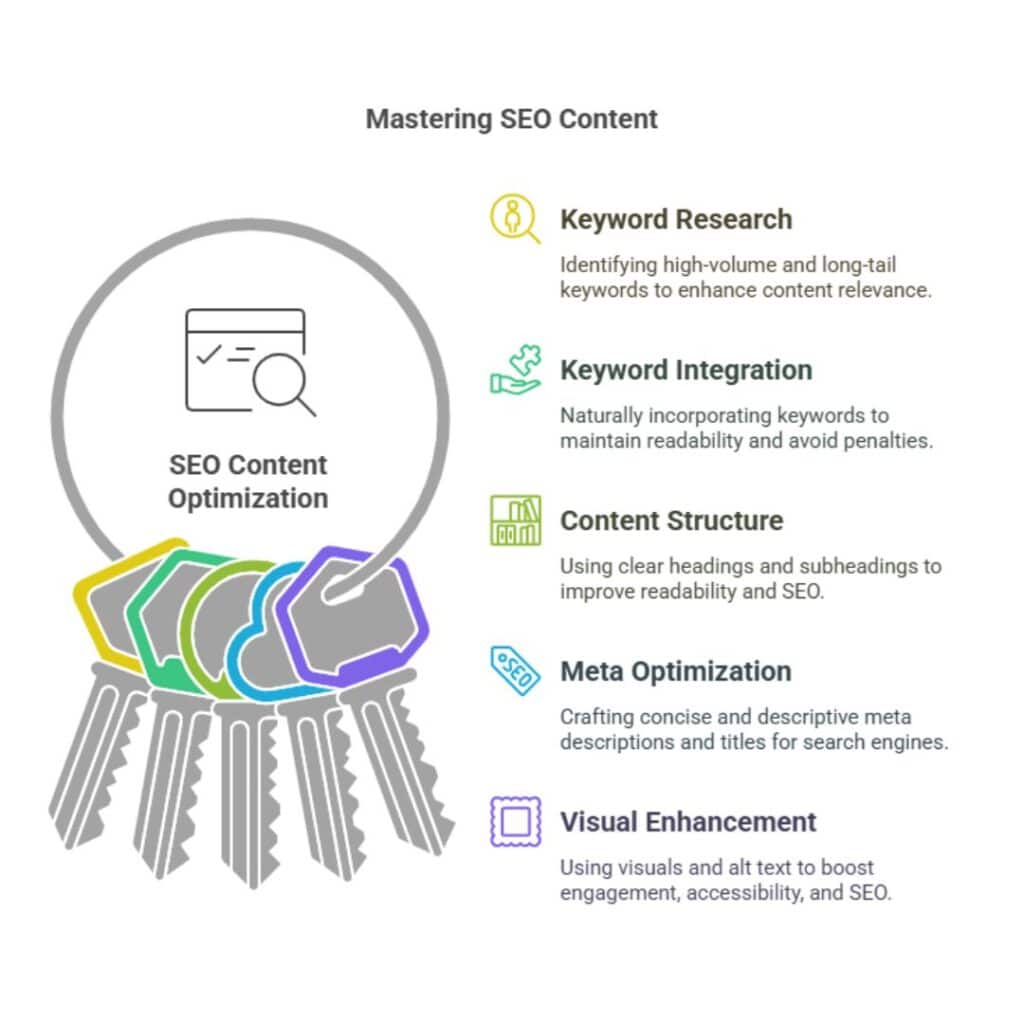
To enhance SEO through basic content writing, start by understanding and analyzing your audience using data tools and personas. Perform thorough keyword research, focusing on long-tail keywords and natural integration throughout the text. Create high-quality material that is unique. Organize it well and make it visually appealing. This will help keep users interested. Enhance website components like meta descriptions, alternative text for images and mobile compatibility to boost accessibility. Employ linking methods within your site and from external sources. This approach enhances navigation flow and establishes content credibility. Regular updates and strategic content promotion are crucial to staying relevant in search engine rankings. Delve into every element to gain a profound grasp of successful search engine optimization techniques.
Key Takeaways
- Conduct keyword research to identify high-volume and long-tail keywords relevant to your content topic.
- Integrate keywords naturally into the content to maintain readability and avoid search engine penalties.
- Structure content with clear headings and subheadings to improve readability and SEO.
- Optimize meta descriptions and titles for search engines, ensuring they are concise and descriptive.
- Use visuals and alt text to enhance engagement and improve accessibility and SEO.

Understand Your Audience

To truly resonate with your readers and enhance your content’s performance on search engines, it’s crucial to get to know your audience intimately. Understanding your audience is a foundational step in crafting valuable content that not only captivates but also serves its purpose in writing for SEO.
By gaining insight into your readers’ preferences, pain points, and interests, you can tailor your content strategy to meet their needs, ultimately improving engagement and search engine rankings.
To understand your content and audience better, start by conducting thorough research. Utilize tools like Google Analytics to gather data on demographics, behavior, and user interests. Analyzing this information allows you to craft content that speaks directly to your audience, making it both relevant and valuable.
Creating audience personas can further refine your approach, providing a clear picture of who you are writing for and what they expect from your content.
Incorporating these insights into your content strategy ensures that your writing aligns with your audience’s expectations and search intent. When writing for SEO, consider how your audience searches for information and what keywords they might use. This approach not only aligns with SEO content writing tips but also enhances the overall user experience, making your content more discoverable and engaging.
Ultimately, successful content hinges on understanding your audience. By prioritizing their needs and preferences, you can create content that not only ranks well but also establishes your authority and trustworthiness in your field.
This understanding is the key to crafting content that truly resonates and delivers measurable results.
Use Relevant Keywords

Incorporating relevant keywords into your content is a cornerstone of effective SEO strategy, as it directly impacts your visibility on search engines. By strategically embedding these keywords, you enhance the probability of your audience finding your site when they search for related topics.
The process of seo keyword research is crucial, as it helps you identify the terms your target audience frequently searches, allowing you to weave these into your writing seamlessly.
Here are some practical steps to effectively use relevant keywords in your content:
- Conduct Thorough SEO Keyword Research: Begin by exploring keyword tools to find popular and relevant search terms related to your niche. This research will help you uncover both high-volume and long-tail keywords that enhance your chances of ranking higher.
- Integrate Keywords Naturally: Avoid keyword stuffing, as it can lead to penalties from search engines. Instead, focus on integrating keywords naturally within your content flow, ensuring that they fit contextually and maintain the quality of writing high-quality content.
- Optimize All Elements of Content: Incorporate keywords not only in the body text but also in other essential areas like meta descriptions, headers, and image alt texts. Such comprehensive optimization is key to creating seo that captures search engine attention effectively.
- Focus on User Intent: Consider what your users intend to find when they type in specific keywords. Tailor your content to meet these needs, which not only aids in optimized content but also enhances user experience and engagement.
Craft Compelling Headlines

Crafting compelling headlines is a vital step in your overall SEO strategy, complementing the foundational use of relevant keywords. A well-crafted headline not only captures the reader’s attention but also signals to search engines the relevance and value of your content.
In the realm of SEO writing best practices, headlines serve as the bridge between your content and its discoverability. They encapsulate the essence of your writing, making it essential to thoughtfully craft compelling headlines that resonate with both search algorithms and human audiences.
Writing content with the goal of engagement requires headlines that provoke curiosity or provide clear information. To create content that ranks, it is crucial to integrate primary keywords seamlessly into your headlines without compromising their appeal. This balance ensures that your headlines meet the needs of search engine crawlers while still engaging potential readers.
Avoid using overly complex language in your headlines; simplicity often aids in clarity and understanding, making the content more accessible to a broader audience.
Another key aspect is to keep your headlines concise yet descriptive. Search engines typically display the first 50-60 characters of a title, so brevity is essential to ensure the complete message is visible. Actionable language can also be effective, prompting readers to take interest and delve deeper into your content.
Optimize Meta Descriptions
While often overlooked, optimizing meta descriptions is a crucial component of effective SEO strategy. A well-crafted meta description not only enhances your SEO but also entices users to click on your link in search results. This small snippet of text is your opportunity to communicate the essence of your content to both search engines and potential readers.
By adhering to SEO best practices, you can significantly improve your website’s visibility and engagement.
Here are some key tips for writing high-quality meta descriptions:
- Be Concise and Clear: A meta description should ideally be between 150-160 characters. This ensures it is fully displayed in search engine results, making it essential to convey your message succinctly.
- Incorporate Keywords Naturally: Including relevant keywords in your meta description is vital for optimizing your content. However, ensure that they appear naturally within the text to maintain readability and avoid keyword stuffing.
- Use a Compelling Call to Action (CTA): Encourage users to take action by including a strong CTA. Phrases like “Learn more,” “Discover,” or “Find out how” can entice users to click on your link, improving your click-through rate.
- Reflect the Content Accurately: Ensure your meta description accurately represents the content of the page. Misleading descriptions may lead to high bounce rates, negatively impacting your SEO efforts.
Structure With Subheadings
Effective content writing for SEO relies on several crucial elements, and one of the most impactful is the use of subheadings. Subheadings, often formatted as h2 headers, play a vital role in structuring content, guiding both readers and search engines through the text.
These basic text terms serve as signposts within your content creation, encapsulating the main ideas of each section and highlighting the writing important points. By clearly delineating sections, subheadings contribute to a seamless reading experience, an essential aspect of on-page SEO.
Incorporating subheadings into your content is more than just a stylistic choice; it’s a strategic SEO move. Search engines use these h2 headers terms to understand the hierarchy and relevance of the content on a webpage. Properly structured subheadings can enhance your page’s search engine visibility, as they provide clear cues about the content’s structure and key themes.
This not only aids in indexing but also boosts the likelihood of appearing in featured snippets, a coveted spot for any content creator.
Moreover, subheadings break down large blocks of text, making the content more digestible. This is especially crucial given today’s digital audience, which often skims rather than reads in depth.
Write for Readability

Subheadings provide a structural backbone to your content, creating a roadmap that enhances both readability and SEO.
As a content writer aiming for good SEO writing, it is crucial to write for readability. The clarity and accessibility of your content directly influence user engagement, which in turn impacts search engine rankings.
When you create content, you must ensure your content is easily digestible, catering to both your audience’s needs and search engine algorithms.
Here are four essential tips to write for readability:
- Use Simple Language: Avoid jargon and complex vocabulary where possible. Readers appreciate content that conveys information straightforwardly. Simplicity not only enhances comprehension but also widens your audience reach.
- Keep Sentences and Paragraphs Short: Long sentences and paragraphs can be overwhelming, causing readers to lose interest. Aim for concise expressions and break down ideas into digestible segments to maintain engagement.
- Incorporate Bullet Points and Lists: Organizing information into lists helps break up text and makes it easier for readers to scan for key points. This format also aids in retaining information and highlights critical details.
- Utilize Visual Elements: Integrate images, charts, and infographics where relevant. Visuals complement textual content, providing a richer understanding and breaking the monotony of text-heavy sections.
Incorporate Internal Links

Incorporating internal links within your content is a strategic way to improve both user experience and SEO performance. By connecting different pieces of content on the page, you guide users to related information, keeping them engaged longer.
This practice not only enhances your content but also helps search engines understand the structure and hierarchy of your website, a crucial aspect of SEO content writing.
When you incorporate internal links effectively, you create a seamless navigation path for your readers, which can increase the time spent on your site and reduce bounce rates. These factors are key when creating content that ranks, as search engines like Google consider user engagement metrics when determining search rankings.
Moreover, internal links pass authority from one page to another, helping to distribute page rank across your site, which can boost the visibility of less prominent pages.
To maximize the benefits of internal linking, ensure that the anchor text is relevant and descriptive, providing context about the linked page. Avoid generic phrases like “click here” and instead use keywords that reflect the target content.
This practice not only informs users but also signals to search engines what the linked page is about, further optimizing your site’s SEO.
Utilize External Links

Leveraging external links in your content is a powerful strategy to enhance SEO and build credibility. When you utilize external links effectively, you not only improve your site’s authority but also provide value to your readers by connecting them to additional relevant resources.
This approach is especially significant for SEO writing, where search engines like Google evaluate the quality and relevance of your links to determine your content’s worth.
Here are four key benefits of utilizing external links:
- Enhance Credibility and Trustworthiness: By linking to authoritative and reputable sources, you can strengthen your content’s credibility. This demonstrates that your information is well-researched and supported by experts, enhancing reader trust.
- Improve Search Engine Rankings: When search engines like Google see that your content is linked to high-quality external sites, they are more likely to view your own content as valuable. This can lead to improved rankings, making it easier for users to find your content.
- Provide Additional Value to Readers: External links allow you to offer readers a deeper understanding of your topic by directing them to comprehensive resources. This helps content to be more informative and engaging, addressing readers’ needs more effectively.
- Build Relationships with Other Websites: By linking to other relevant sites, you can foster connections with other content creators and websites. These relationships might lead to reciprocal linking opportunities, further broadening your audience reach.
Focus on Quality Content

Quality content is the cornerstone of successful SEO, serving as the primary determinant of how well your website performs in search engine rankings. The process of creating content that is not only engaging but also informative plays a crucial role in attracting organic traffic. SEO writing is the process of strategically crafting content to align with search engine algorithms while catering to the needs of your audience. To achieve this, it is essential to focus on delivering value through well-researched and thoughtfully articulated ideas.
The writing process involves several stages, beginning with understanding the topic and identifying the target audience. This ensures that the content is relevant and resonates with readers. Informative content that addresses the questions and challenges faced by your audience not only strengthens your SEO efforts but also establishes your website as a credible source of information.
Below is a table outlining elements that contribute to quality content:
| Element | Description | Importance |
| Relevance | Content aligns with audience interests | Enhances engagement and retention |
| Originality | Unique perspectives and insights | Differentiates from competitors |
| Clarity | Clear and concise language | Improves reader comprehension |
| Depth | Comprehensive coverage of the topic | Builds authority and trust |
| Engagement | Interactive elements and calls to action | Encourages reader interaction |
To create content that excels in these areas, it is crucial to incorporate the latest information and trends pertinent to your industry. This continuous refinement of your writing process ensures that you consistently deliver quality content, thereby optimizing your website’s SEO performance and enhancing its visibility in search engine results.
Update Regularly

To maintain and enhance your website’s SEO performance, regular updates to your content are essential. Consistently refreshing and updating your content not only keeps your audience engaged but also signals to search engines that your site is active and relevant.
Here are some effective strategies to ensure you update regularly:
- Identify Content Opportunities: Regularly audit your existing content to identify areas where updates are needed. Look for outdated information, changes in industry trends, or new insights that can be incorporated.
This approach not only enhances the value of the content you write but also opens up new content opportunities to explore.
- Focus on Timeliness and Relevance: Ensure the content you write is up-to-date and relevant. Search engines prioritize websites that provide timely and pertinent information.
Regular updates help maintain this relevance, which can improve your search engine rankings and increase traffic.
- Engage with Audience Feedback: Use feedback and comments from your audience as a source of content opportunities. By addressing questions or suggestions, you can create relevant content that meets the needs of your audience, while also keeping your site fresh and engaging.
- Leverage Analytics: Use analytical tools to track which content is performing well and which is not. This data provides insights into what topics resonate with your audience, allowing you to update regularly with content that aligns with their interests and enhances your site’s SEO efficacy.
Final Thoughts
Incorporating basic content writing techniques into your SEO strategy is essential for improving both visibility and user engagement. By understanding your audience, conducting thorough keyword research, and focusing on high-quality, well-structured content, you can boost your website’s ranking and relevance. Regular updates, strategic use of internal and external links, and a focus on readability further enhance user experience, making your content more discoverable and impactful.
Ready to elevate your content’s SEO performance? Connect with Syville Gacutan, an experienced SEO Specialist in the Philippines. Syville can help you optimize your content for better visibility, create keyword-rich articles, and ensure your website stays competitive in search engine rankings. Reach out today and start transforming your content strategy for success!